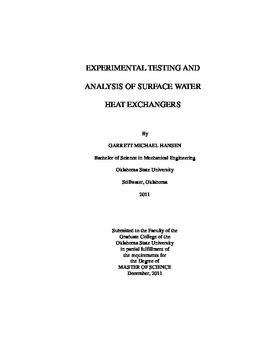| dc.contributor.advisor | Spitler, Jeffrey D. | |
| dc.contributor.author | Hansen, Garrett Michael | |
| dc.date.accessioned | 2014-04-17T19:52:28Z | |
| dc.date.available | 2014-04-17T19:52:28Z | |
| dc.date.issued | 2011-12-01 | |
| dc.identifier.uri | https://hdl.handle.net/11244/9941 | |
| dc.description.abstract | When looking at the heat exchanger of a surface water heat pump (SWHP) system the material of choice these days is high density polyethylene (HDPE). HDPE coils provide high corrosion resistance and minimal impact on the surrounding environment, but at a cost of high thermal resistance. Although the internal convective resistance and conductive resistance are well known, the exterior resistance due to natural convection is poorly understood. In this thesis, 119 experiments were conducted on heat exchangers in the following forms: controlled spacing spiral-helical coils, bundled coils, flat-spirals, vertical slinky, horizontal slinky, and vertical flat-plate heat exchangers. Exterior convective resistances were estimated using an ε-NTU heat exchanger analysis. For each geometry, natural convection correlations were developed. Applications of the results to design procedures and heat exchanger design are also investigated. A correlation for spiral-helical surface water heat exchangers (SWHE) that gives Nusselt number as a function of modified Rayleigh number, with corrections for horizontal spacing and vertical spacing is developed. This correlation yields an RMSE error of 21% for the outside convection coefficient which results in an RMSE error in the heat transfer of less than 6%. Using this correlation, design graphs for SWHE were created giving the size as a function of approach temperature difference. The second-order effects of lake temperature and heat pump efficiency on SWHE sizing are also determined. Three scenarios for the continental United States (northern, central, and southern) using the design graphs are provided. Using findings in the research regarding the distribution of thermal resistances, several design improvements such as the use of thinner walled HDPE, thermally enhanced HDPE, and metal heat exchangers are also provided. Reduction in sizing for the suggested design improvements ranged from 14% - 77% when compared to SDR-11 HDPE tubing with sizes of 19 mm - 32 mm (�" - 1-�"). | |
| dc.format | application/pdf | |
| dc.language | en_US | |
| dc.publisher | Oklahoma State University | |
| dc.rights | Copyright is held by the author who has granted the Oklahoma State University Library the non-exclusive right to share this material in its institutional repository. Contact Digital Library Services at lib-dls@okstate.edu or 405-744-9161 for the permission policy on the use, reproduction or distribution of this material. | |
| dc.title | Experimental Measurement and Analysis of Surface Water Heat Exchangers | |
| dc.type | text | |
| dc.contributor.committeeMember | Cremaschi, Lorenzo | |
| dc.contributor.committeeMember | Fisher, Daniel | |
| osu.filename | Hansen_okstate_0664M_11740.pdf | |
| osu.college | Engineering, Architecture, and Technology | |
| osu.accesstype | Open Access | |
| dc.description.department | Mechanical & Aerospace Engineering | |
| dc.type.genre | Thesis | |
| dc.subject.keywords | heat exchangers | |
| dc.subject.keywords | heat pumps | |
| dc.subject.keywords | swhp systems | |
| dc.subject.keywords | thermal systems | |
